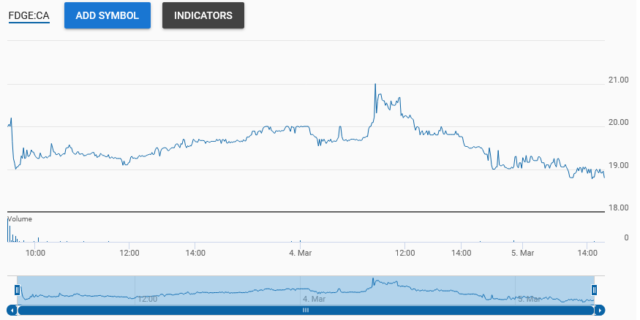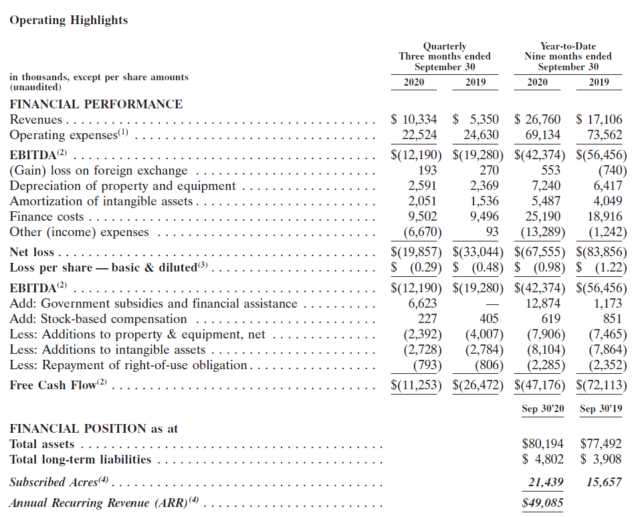I don’t talk about IPOs very often, but this one caught my attention because of its presence in the agricultural space. Farmer’s Edge (TSX: FDGE) went public at an IPO price of $17/share, raising $125 million in gross proceeds ($117.5 net), and started trading on the TSX on March 3rd. Unlike many other technology IPOs, they have at a modest premium to their offering price:
There is a customary 30-day option by the underwriters to purchase more shares, which at the current market price of CAD$18.80 is likely to happen. I will assume so – the company will have 41.8 million shares outstanding if this happens.
Fairfax (TSX: FFH) owns 60% of the company after the offering and is the only 10%+ shareholder.
(Update March 8, 2021: The stock is now trading under CAD$17/share, that was quick… FFH will own 62% without the exercise of the over-allotment).
(Update March 9, 2021: Underwriters have exercised the over-allotment option – gross proceeds $143.8 million).
Company’s Operations
FDGE offers a package called FarmCommand. It is a piece of software which integrates with provided hardware (CanPlug) which facilitates a data conduit to the software relevant to measuring grain weight by location during a harvest. The software beams the information to the cloud using cellular data, and the software crunches the metrics and presents it to the end-user. Likewise, they also sell weather probes and soil moisture probes that can send data to the server (and this data can be used to make correlations at future times). Finally, they do have a soil sampling service that looks painfully manual and will test the soil for composition, using their own lab equipment. This information can be used later to suggest fertilizer solutions.
They use Google to store the data to the cloud, and Airbus to provide satellite imagery.
Revenues are obtained by selling farmers the FarmCommand package on a per-acre-per-year basis and also collecting such data to sell to crop insurance companies.
Relevant quotes:
FarmCommand is sold on a subscription basis, per acre per year, and is offered in five principal tiers. We focus on selling our $3.00 Smart package but offer price points starting at $1.50 for a basic Smart Imagery package, scaling to $6.00 for our comprehensive Smart VR package, with these list prices and packages varying marginally by geography. Our customers have historically subscribed to four-year contracts. Recently, we have introduced our Elite Grower program which allows our customers to trial our platform for free for up to one year before subscribing to a four-year contract.
…
Crop insurance partners form part of our go-to-market strategy and we expect them to sell our subscription products to their agriculture customers. Once our program is deployed on the farm by a crop insurance company, Farmers Edge will be able to provide reporting, analytics and predictive modeling to the crop insurance industry players on demand.
This reminds me of car insurance companies getting people to voluntarily put a device in their car dashboards for the purpose of insurance assessments. If you are a “safe” driver, as in you don’t drive that much and when you do, you drive at low speeds, then the insurance company will give you a discount. In reality, they will use this information to determine more accurate pricing, which is why there is a significant degree of selection bias with such offerings.
I also believe certain farm operations have proprietary methods that they would not want to disclose, which would work to the detriment of FDGE.
FDGE states they estimate at the end of Q4-2020, they have 23.4 million acres of subscribed farmland, and an estimated revenue of $45-47 million for 2020. 54% of this was Canada, 28% was USA, and 13% was Brazil, and the remaining 5% is Australia and Eastern Europe.
Keep in mind rough estimates are that Canada has 90 million acres of cropland, the USA has 250 million acres and Brazil 150 million. The total addressable market in these geographies assuming 100% penetration and the $3/acre package would be about $1.5 billion a year in revenues.
The company claims it adds value:
The ROI our solutions provide farmers vary by product and region. As additional examples, corn farms implementing our solutions earned farmers roughly $52 more per acre in Nebraska, and $36 more per acre in Kansas, compared to state averages, in 2019.
Clearly if this is the case and if they can establish this with better studies and have a proprietary advantage with their software to make it happen, then one can presume they can capture more margin than $3/acre.
In terms of competition, they list John Deere (NYSE: DE) and Bayer-Monsanto (OTC: BAYZF), but they allude to a “Point and regional solution providers” which is clearly referring to Ag Growth (TSX: AFN), but they are never named quite likely for the reason that they are the true competition.
Finances
The company has lost a lot of money over the past 3 full fiscal years. The “finance costs” is somewhat misleading as the company has been financed with debt before the IPO and this was equitized for the IPO.
In terms of raw EBITDA, and the accumulated non-capital loss for tax purposes (which is a rough proxy for true expense), we have:
2017: $53.8 million loss / $130 million
2018: $76.4 million loss / $199 million
2019: $74.2 million loss / $309 million
9 months in 2020: $42.4 million loss (annualized, $56.5 million) / tax NOLs not disclosed yet
This is also ignoring capital costs, which are not inconsiderable as the company has to get the hardware into the farmers’ hands (in addition to the installation) in order to do the data collection.
The company gave projections for 2020 and is expected to have burnt $52-56 million. Because of the renegotiation of the Google contract and the satellite imagery contract (which has been re-contracted to a subsidiary of Airbus), they are expected to save an annualized $15 million in costs (makes you wonder how they managed to negotiate the deals in the first place – this was not an inconsiderable cost savings).
The company has been mostly funded by Fairfax during inception. There are a couple other under-10% holders, one of which (Osmington Inc.) has the right to a board seat as long as they maintain at least 5% ownership.
After the IPO they will have converted all of their debt into equity, and have a pro-forma $106 million of cash on the balance sheet as of September 30, 2020 and the only significant debt being $6.5 million in future lease obligations.
They claim “break-even for Free Cash Flow in the medium term, assuming growth in Subscribed Acres remains consistent with the above expectations” (45-50% annually). Of course you will if you grow high-margin revenues at that rate! While achieving that percentage growth is indeed possible, the question remains whether they can do it profitably (it is difficult to make money giving out 1-year free trials and not cashing them into 4-year contracts), and the terminal growth rate of the business (it will not be 45-50% annually for a very long time, especially given the acreage penetration they have already achieved).
I’m not going to comment on the management suite or the board of directors, but I have reviewed them.
Some analysis on the software
There’s a lot of interesting information on how to use their product online. For instance here is one particular function within their FarmCommand software, but also as part of a series of instructional videos:
This competes with AGI’s Suretrack Compass software:
I’m finding this comparison between the two softwares to be interesting. AGI’s solutions are obviously vertically integrated with some of their products (their grain silos), while FDGE’s solutions are a horizontal turnkey solution. There is a lot of overlap. I would suspect that part of the reason why FDGE has spent a ridiculously large amount of money to date is to just get farmers aware of the software – they don’t have any inroads to the end-customers that a company like AFN or John Deere would have.
The other observation is that these Youtube videos that I linked to have views that are measured in the low hundreds. Almost nobody has watched these videos. There appears to be zero public awareness of agricultural software. If at some point these companies receive more eyeballs (heaven forbid if /r/WallStreetBets decided to hit it), there aren’t a lot of public companies in this space that would receive instant elevation to their valuations.
Consider that the weekend market capitalization for FDGE is $765 million – higher than Ag Growth’s $715 million (albeit, Ag Growth has a considerable amount of debt on their balance sheet, about $870 million), it makes one wonder how to reconcile the valuation differential. Is this attributed to FDGE as being some sort of “pure SaaS play in the Ag Space”, while Ag Growth is a much larger conglomerate (set to exceed a billion dollars in revenues), primarily concerned with the (relatively more boring) design and construction of grain towers and movers rather than having their own piece of software, which by all accounts does mostly what FDGE does?
I’m not interested in FDGE at current valuations, but I’ll watch it. If it turns out the current valuation of FDGE is “correct”, Ag Growth is incredibly undervalued.
Disclosure – I presently own shares in Ag Growth (posted here).


Admittedly I just watched the soil sampling video with no sound on, but FDGE’s soil sampling solution is painfully manual, and no less manual than the soil sampling I did/do where you drive around with a probe and a bucket.
I don’t see anything proprietary vs sampling and mailing your soil to A&L like we do and you can get done by any fertilizer retailer (who will give basic fert recs if you do it through them)
The value I believe FDGE provides here is taking care of the geographical tagging of your samples and the dumping of information into their software platform so you don’t have to scribble down GPS coordinates I guess!
If the Farmer’s Edge samples can automatically sync up with a variable rate spreader or floater, I can see the value (depending on the cost). Most farmers in my experience aren’t using variable rate, and most just want one fertilizer per field. OMAFRA suggests 1 sample per at most 25 acres, we’d typically recommend 20, but I can’t tell you how many times a farmer would tell me “I’m not putting more than one blend on anyway, just do one sample” when I asked how many samples he wanted off a 100 acre field.
I don’t think they’re at that level of sophistication yet. It’s also where I think Deere and those equipment manufacturers would have a natural competitive advantage over the pure software firm.
This stock reminds me of the hype around a small cap about 6-8 years ago now called AgJunction which was supposed to be the “new” thing for agriculture using GPS for crop planting. Another one of my small cap losers where the story was a lot bigger than the actual results.